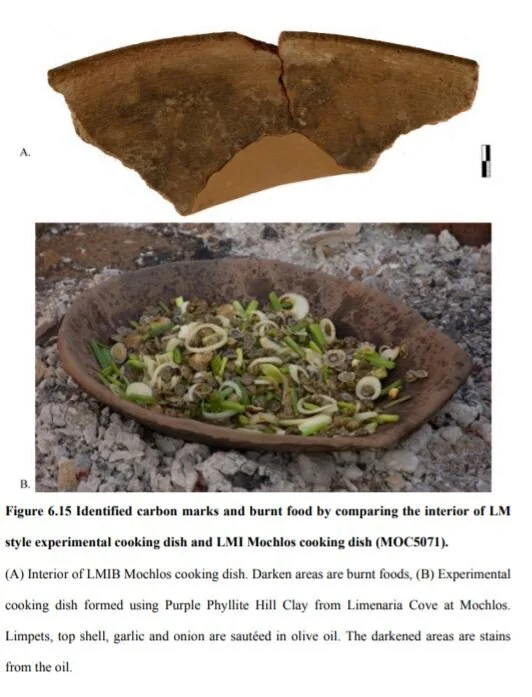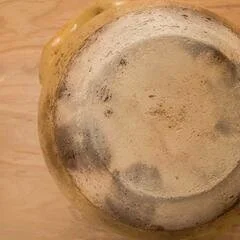Point of Origin Episode 7
Earthenware Cooking from Japan to Greece
When we think about food origins, often we talk about the movement of people, plants, animals and ideas. But the study of humans would be an incomplete one without the study of the clay and ceramic vessels, one of humankind’s earliest innovations. If pottery is a conversation with the past, archeologists are our interpreters.
Today we’re talking to a whisperer of ancient history, culinary archeologist Jerolyn Morrison. Jerolyn has a Ph.D in archeology specializing in the cooking vessels of ancient Crete. We also meet Naoko Takei Moore who enlightens us on the miracle of donabe, the ceramic pot that is one of the oldest Japan. Naoko is a food expert, and author of the Donabe cookbook and owner of Toiro Kitchen in Los Angeles, a purveyor of fine Japanese ceramic cookware.
Available on Apple Podcast, Spotify, & iHeartRadio
Of Burnt Lentils and Shellfish
Centered around the Aegean island of Crete, The Minoan civiliation flourished from around 2700 to 1450BC. Named “The Sea Peoples” by their Egyptian trading partners, Minoan pottery was traded far and wide benefiting from the Island’s fortuitous position at the insection of key seafaring trade routes.
While decorative, highly stylized animal portraitures (like this Minoan Bull) may come to mind when discussing Minoan pottery, food wares and food storage vessels were also highly valued for the fine quality of clay and for the highly advanced, thin vessel walls.
Jerolyn Morrison brings us back in time as she discusses her archealogical excavation work and the insights that connect us to those who cooked thousands of years before us. We learn about the original key discovery of adding metamorphic rock to clay collected from the riverbeds that gave ancient Minoan ceramics the ability to withstand thermal changes. What secrets lie in ancient fragments of brown-black pottery and remnants of burnt lentils?
Source: Morrison, Jerolyn. The Art and Archaeology of Cooking: a Comparative Study of Late Minoan Cook-pots from Mochlos and Papadiokambos. https://lra.le.ac.uk/handle/2381/36611
Jerolyn is the founder of Minoan Tastes, a social enterprise promoting the culinary history of ancient Crete by working together with a network of food experts, historians, potters, and archaeologists. Jerolyn invites you to experience the delicious flavors of Minoan cooking - give her lentils recipes a try!
Brown Lentils with Crushed Coriander and Honey
Recipe By: Minoan Tastes
Combine the lentils, garlic, coriander with 800 ml of water in a medium pan over high heat, and bring to a boil. Once boiling, cover the pot, reduce the heat, and simmer for 45 minutes, or until tender. When tender, turn off the heat and add 1 or 2 bay leaves and stir in the honey. Let sit for 15-20 minutes, and then taste, adding more honey if desired.
To serve, spoon into small cups, top with a healthy drizzle of fresh olive oil (about a tablespoon for each cup), and season with sea salt.
Ingredients:200 grams brown lentils
3 tablespoons crushed coriander seeds
1 to 2 garlic bulbs
2 to 3 bay leaves
1/4 cup of honey, or more
Olive oil for drizzling
Sea salt to taste
Serves: 4-5 people
Cook time: 45-60 minutes
Donabe : 土鍋 : ‘Clay’ + ‘Pot’
Japan’s Traditional Earthen Cookware
Tracing back over 10,000 years, Donabe remains one of the most important and versatile vessels in Japanese cooking.
These everyday cooking companions are versatile: use them to make hot pot, cook soup, stew, for steaming fish or vegetables, making rice, or even grilling! The Donabe’s versatility can also be seen in it’s diverse forms - from small personal sized serviceware to large pots made for gatherings.
Naoko Takei Moore is the author of DONABE and owner of Toiro, a brick and mortar filled with authentic Iga-yaki donabe and pottery products by Nagatani-en. At Toiro, Naoko takes immense pride in curating the highest quality Japanese ceramics and cookware - as she explains in our conversation, she’s inspired by the spirit of Donabe and it’s her mission to Japanese food culture and healthy lifestyles. Toiro’s donabe is handcrafted by generational artisans in Japan, and it’s made from clay sourced from what used to be an ancient lake bed millions of years ago.
Wabi-Sabi : 侘寂 : Wisdom in Natural Simplicity
Wabi-Sabi is a uniquely Japanese viewpoint, it is broadly translated to the notion that natural imperfections are inherent in our universel; in ceramics, wabi-sabi evidences that each individual piece has it’s own story, character and place in the world.
Images: https://toirokitchen.com/
Wabi-Sabi is reflected here in nuance of glaze, some stray spots and speckles, and bumps or even marks or chips. In a well-used and loved donabe, wabi-sabi becomes more prevalent after each cook, with black spots appearing on bottom. Don’t turn the heat up too high though! Donabes that have turned black on the bottom after just a few uses indicate that the heat is too high. Interested in learning more about cooking with donabe? Check out some of Naoko’s recipes!










